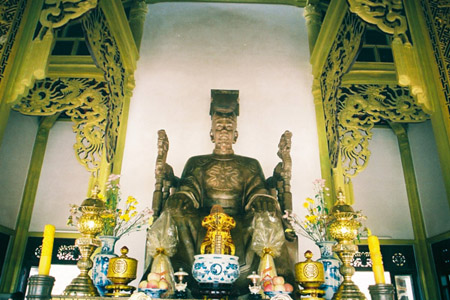The Bach Dang victory of Ngo Quyen in 938 against Southern Han invaders ended the thousand-year Chinese domination, and Vietnam entered a new age of independence, sovereignty, and development. However, after Ngo Quyen's death, the chaos of Twelve Warlords afflicted the country (946-968).
Vietnamese History under Dinh & Le Dynasty
Dinh Dynasty
In 968 Dinh Bo Linh from Hoa Lu, Ninh Binh, rose up in arms to defeat various warlords and assume the throne. He proclaimed himself Emperor Dai Thang Minh, taking the nickname Dinh Tien Hoang (968-979), the reign name of Thai Binh. He named the country Dai Co Viet, establishing the capital in Hoa Lu.
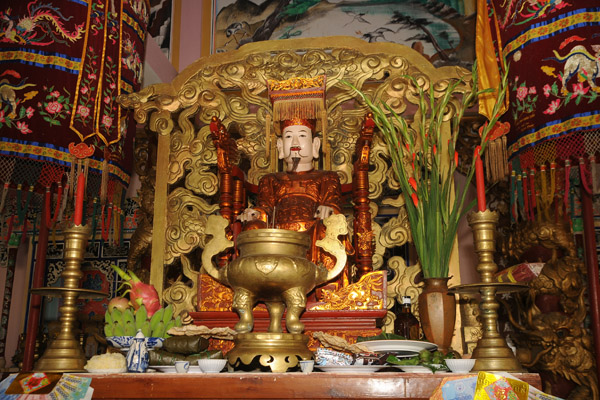
Early Le Dynasty
After Dinh Tien Hoang was assassinated by eunuch Do Thich, there was a division within the Dinh family, and the Song Dynasty invaded the country. For the sake of the country, Queen Mother Duong Van Nga handed over the throne to the Commander-in-chief Le Hoan (941-1005) to lead a resistance against the invaders. Le Hoan proclaimed himself King Le Dai Hanh. After defeating the Song invaders, Le Dai Hanh consolidated the army to defend the country and at the same time speeding up agricultural and handicraft production to help the country to prosper. The Le Dynasty had three rulers: Le Dai Hanh (980- 1005), with the reign names of Thien Phuc, Hung Thong or Ung Thien; Le Trung Tong (1005); Le Long Dinh (1005-1009), with the reign names of Ung Thien or Canh Thuy.
Vietnamese History under Ly Dynasty
Le Long Dinh (1005-1009) usurped the throne. Idle, wicked, and lustful, he was detested by everyone. In 1010, after the death of Le Long Dinh, the court supported the ascension of Ly Cong Uan from Tu Son, Bac Ninh, to the throne. Before becoming king, he was the Commander of the Royal Troops. He proclaimed himself Ly Thai To, marking the beginning of the Ly Dynasty. He renamed the country Dai Viet. The Ly Dynasty had nine kings: Ly Thai To (1010-1028) with the reign name of Thuan Thien; Ly Thai Tong (1028-1054) with the reign names of Thien Thanh, Thong Thuy, Can Phu Huu Dao, Minh Dao, or Thien Cam Thanh Vo; Ly Thanh Tong (1054-1072) with the reign names of Long Thuy Thai Binh, Chuong Thanh Gia Khanh, Long Chuong Thien Tu, Thien Chuc Bao Tuong or Than Vo; Ly Nhan Tong (1072-1127) with the reign names of Thai Ninh, Quang Huu, Hoi Phong or Thien Phu Khanh Tho; Ly Than Tong (1128-1138) with the reign names of Thien Thuan or Thien Chuong Bao Tu; Ly Anh Tong (1138-1175) with the reign names of Thieu Minh, Dai Dinh or Thien Cam Chi Bao; Ly Cao Tong (1176-1210) with the reign names of Trinh Phu, Thien Tu Gia Thuy or Tri Binh Long Ung; Ly Hue Tong (1211-1224) with the reign name of Kien Gia; and Ly Chieu Hoang (1224-1225) with the reign name of Thien Chuong Huu Dao. The Ly dynasty helped make Dai Viet a prosperous and powerful country for over two centuries. The centralized feudal regime was well-organized. Hinh thu, the first written law code, was announced. Internal policy focused on stabilization and development. Policy on external affairs aimed at defeating the Song and the Chiem. By moving the capital from Hoa Lu to Thang Long (1010), the Ly dynasty opened a new cultural age for Vietnam, the age of Thang Long Culture.
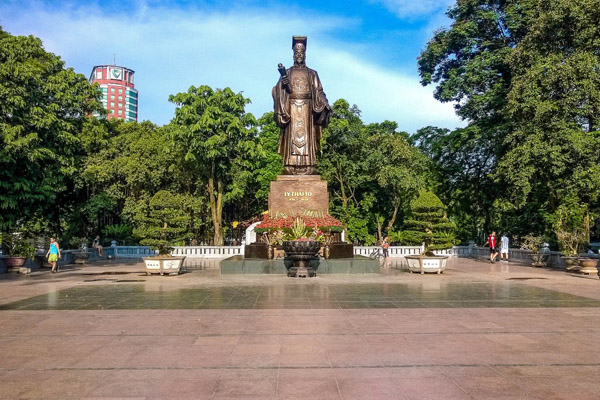
Vietnamese History under Tran Dynasty
However, under the reign of Ly Cao Tong and Ly Hue Tong, due to their indulgence in dissipation and neglect of court affairs, the court was reigned by dishonesty and deceit. Starvation was a constant problem. As a consequence, the Ly Dynasty fell into decline, leading to the establishment of the Tran Dynasty in 1225 on the merits of Tran Thu Do. The Tran Dynasty lasted for 175 years, from 1225 to 1400 with twelve kings: Tran Thai Tong (1225-1258) with the reign names of Kien Trung, Thien ung Chinh Binh or Nguyen Phong; Tran Thanh Tong (1258-1278) with the reign names of Thieu Long or Bao Phu; Tran Nhan Tong (1279 - 1293) with the reign names of Thieu Bao or Trung Hung; Tran Anh Tong (1293-1341) with the reign name of Hung Long; Tran Minh Tong (1314-1329) with the reign names of Dai Khanh or Khai Thai; Tran Hien Tong (1329-1341) with the reign name of Khai Huu; Tran Du Tong (1341-1369) with the reign names of Thieu Phong or Dai Tri; Tran Nghe Tong (1370-1372) with the reign name of Thieu Khanh; Tran Due Tong (1373-1377) with the reign name of Long Khanh; Tran Phe De (1377-1388) with the reign name of Xuong Phu; Tran Thuan Tong (1388-1398) with the reign name of Quang Thai; and Tran Thieu De (1398-1400) With the reign name of Kien Tan
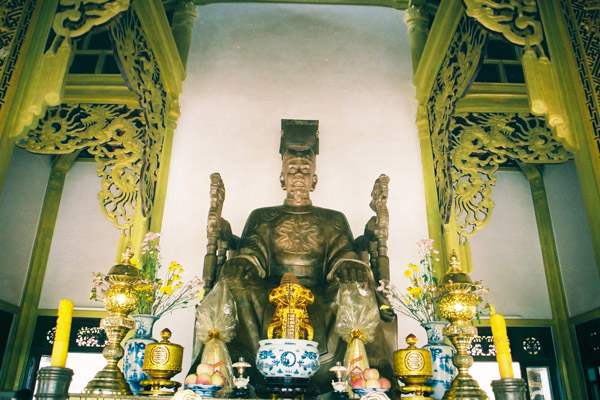
Under the Tran Dynasty (1226-1400), the centralized feudal regime was restored and strengthened. Thong che was compiled to define state regulations and rites. Agricultural production developed under a policy on farms and fiefs. Arts and literature III the Thang Long Culture flourished. National spirit was enhanced by three great victories against Yuan-Mongol invasions, under the leadership of national heroes like Tran Thai Tong, Tran Thanh Tong, Tran Nhan Tong, and General Tran Hung Dao.
Buddhism in Dinh, Le, Ly, Tran Dynasty
Thus, from the tenth century on, Vietnam entered an age of independence and self-determination after one thousand years under Chinese domination, also creating favorable conditions for Buddhism to gain a new impetus for development. Under the Dinh and Le Dynasties, there was a policy to support Buddhism and although it was not officially declared the national religion, it was nevertheless recognized as the country's principal religion. Kings of the Dinh and Le Dynasties paid high respect to Buddhism and rewarded monks who contributed to court affairs. After ascending the throne, Dinh Tien Hoang defined ranks for court officials, and in 971 convened a council of eminent monks to define ranks for the clergy in categories like Quoc su (Imperial Buddhist Preceptor), Tang thong, Tang luc, Tang chinh, and so on. These ranks continued to be used by later administrations. During the Dinh and Le Dynasties, there were a number of eminent monks who made contributions to national independence such as the four Ch'an Buddhist monks Khuong Viet, Phap Thuan, Ma Ni, and Dang Huyen Quang. Their names and deeds are recorded in Vietnam's official history.
Ch'an Master Khuong Viet (933-1011), whose given name was Ngo Chan Luu, was a descendant of Ngo Quyen. He studied Confucianism. When he grew up, he became a monk under the instruction of Ch'an Master Van Phong at the Khai Quoc Pagoda. By the time he had reached the age of forty, his knowledge of Buddhism and his piety had become widely known. He was honored by King Dinh Tien Hoang, who often invited him to the court to discuss religious and national affairs. Khuong Viet was given the title Thai su, or "Paragon of the Nation," a distinction equal to Tam cong (the three highest ranks in the court). Subsequently, he was nominated as Tang thong, the highest-ranking Buddhist in the country. He participated in administering court affairs like a prime minister and often discussed important Court affairs with the King, also acting as the Royal Representative to receive visitors on behalf of the King. In 986, Li Jue, an envoy from the Chinese Song Court, came to Vietnam and met with Khuong Viet. Admiring his brilliance, Li Jue composed a poem praising him as representative of Vietnamese talents:
Now, you act as an advisor to a clear-sighted king.
I have twice been to your Southern country as envoy
How much I reminisce over our get-togethers
And your immense country will never fade away in my eyes.
The native village of Ch'an Master Phap Thuan (family name Do) is uncertain. He was born in 915 AD and left home at an early age to become a monk. He spent his religious life in the Long Tho Pagoda and lived to the age of seventy-five. He is the tenth descendant of the Vinitaruci Ch'an school. He was well-versed in literature and became so knowledgeable about the internal and external affairs of the kingdom that he became a trusted advisor to King Le Dai Hanh. In 986, when Li Jue arrived in Vietnam, Phap Thuan disguised himself as a boatman to ferry the envoy across the river, an occasion on which he exchanged a famous four-line poem with the visitor. When boating, Li Jue saw a couple of geese on the river. He improvised two lines of verses:
A couple of wild geese
Stretch their necks and gaze at the horizon
Phap Thuan then uttered two more lines to complete the poem:
Their white feathers stand out against blue water
Their pink legs paddle in azure waves.
At one time, King Le Dai Hanh asked Phap Thuan about the country's fate and how to govern his people. The monk provided a verse that not only addressed the policy of governing the country and dealing with its citizens but also sounds like a declaration of independence
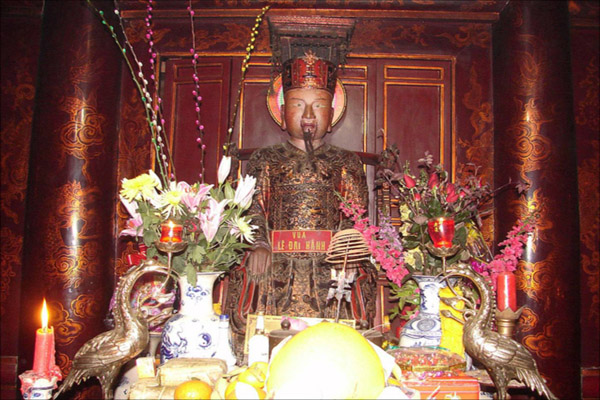
Our nation is now solid as twisted rattans Peace will rein under this Southern sky Inactivity prevails in the Palaces And war will stop everywhere.
The Dinh and Le Dynasties not only paid high honor to bonzes but also encouraged the development of Buddhism. The Kings, especially King Dinh Tien Hoang and King Le Dai Hanh, ordered the construction and renovation of many pagodas, including famous pagodas like Kien So, Kien Duong, Thien Chung, Luc To, Song Lam, Cam ung, Cat Tuong, and Khai Quoc. In the Imperial City of Hoa Lu (present-day Ninh Binh), the Kings committed substantial funds to build many large- scale Buddhist monuments, making it one of the major Buddhist centers of the country that can be compared to the center of Luy Lau (present-day Bac Ninh) built in the early centuries. The pagodas of Ba Ngo, Thap, and Nhat Tru are recorded in historical documents as imposing constructions. Of note is the Nhat Tru Pagoda built-in 995 with an octagonal three-meter-high stone pillar. Unfortunately, over the course of time, they have been ruined, leaving only vestiges behind. The Dinh Kings also ordered the erection of stone pillars inscribed with Buddhist scriptures and incantations for posterity.
Thus, it can be seen that the emergence of a strong soci-political interface between Buddhism and the state was one of the distinctive features of the period to the benefit of government and people. A good example can be drawn from the beginning of the eleventh century, during the political and social chaos precipitated by Le Long Dinh, which resulted in a situation that threatened to weaken Vietnamese independence.
Buddhist monks of the time played a role in shaping public opinion and choosing the king. They helped to bring about non-violent political change which successfully stabilized the situation and 'prepared the ground' for a strong ruler to step in and create favorable conditions for the consolidation of the forces that would help safeguard national independence and security. There was also strong coordination between Buddhist organizations and the army, one of the distinctive characteristics of the first period of national independence.
The Ly Dynasty (1009-1225) is considered to be the first Buddhist reign in Vietnam. King Ly Thai To, the founder of the Ly Dynasty, was the pupil of Ly Khanh Van and was initiated into monkhood with monk Van Hanh and fully supported Buddhism. Later, after his enthronement, Ly Thai To instituted titles for the clergy. In 1010, after moving the capital to Thang Long, he ordered the construction of many pagodas throughout the country while developing the new capital. He also reserved a large fund for the rebuilding and restoration of large pagodas in Thang Long like Hung Thien, Van Tue, Thang Nghiem, Thien Vuong, Cam Y, Thanh Tho, and Thien Quang. He also ordered the construction of eight pagodas in Thien Duc prefecture (his native land). In 1019, Ly Thai To assigned two envoys, Pham Hac and Nguyen Dao Thanh, to go to China to ask for copies of the Buddhist scriptures (Tripitaka). This contributed to the propagation of Buddhist tenets. Then the King entrusted Ch'an Master Phi Tri to organize a ceremonious reception of the sutras and to build a house for storing them. In addition, he issued a decree encouraging people to become monks. In 1024, the King had the Chan Giao Pagoda built inside the royal citadel for Buddhist worship and to serve monks who came to teach. Then in 1026, he issued a decree making bells for Hung Thien, Dai Giao, and Thang Nghiem pagodas. It can be said that under the reign of King Ly Thai To, with the support of Buddhism and the instruction and help of eminent monks like Ch'an Masters Da Bao and Sung Pham and especially through the role of Imperial Buddhist Preceptor Van Hanh, Vietnamese society became stabilized; the country was prosperous and peaceful with independence fully protected. The Northern feudal army did not intervene in local affairs and indeed, good relations were maintained and improved. Also, Southern countries like Champa (Chiem Thanh in Vietnamese) and Chenla (Chan Lap in Vietnamese) agreed to pay tribute to Vietnam.
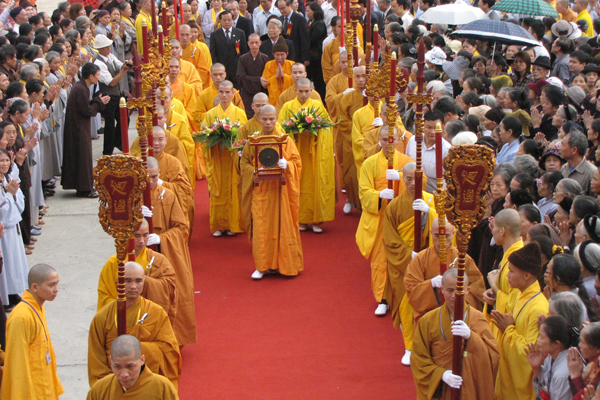
The next king in the succession, Ly Thai Tong (1028-1054) followed his father in supporting the development of Buddhism. Ly Thai Tong is the seventh descendant of the Wu Yan Tong Ch'an school. He often consulted renowned Ch'an Master Thien Lao. In 1031, after defeating Chiem Thanh in Chau Hoan (present-day Nghe An Province), as a manifestation of his gratitude to Buddhism, Ly Thai Tong ordered the construction of ninety-five pagodas and granted a one-year tax exemption to the people. He also assigned people to travel to China to ask for copies of the Tripitaka to help strengthen and broaden Buddhism in Vietnam. Between 1036 and 1041, according to King Ly Thai Tong's edict, thousands of Buddhist statues were produced (noteworthy among these was the statue of Amitabbha, which was 7,560 kilograms in weight and placed at the Thien Phuc Institute), thousands of Buddhist pennons made, and Buddha statues in pagodas gilded or vermillion-lacquered again. When all the projects were completed, the King decided to grant a one-year tax exemption. In 1049, after the King dreamed that the Avalokitesvara guided him into the Buddha's throne, he ordered the construction of Thien Huu Pagoda, nowadays known as (Mot Cot) One Pillar Pagoda.
King Ly Thanh Tong (1054-1072) and Queen Y Lan were both devout Buddhists. There are many historical records that speak of Ly Thanh Tong's compassion for those suffering misfortune, the poor, and prisoners. Ly Thanh Tong also ordered the construction and restoration of a great number of pagodas and the creation of Buddhist statues. In 1056, by his edict, a bronze bell 12,000 kilograms in weight was cast with inscribed text composed by the King himself. In 1055, the Bao Thien Tower was built and listed as one of the "four great cult objects" of An Nam (Vietnam) under the Ly Dynasty (also including the Quy Dien Bell, Pho Minh Urn, and Quynh Lam statue). In 1058, the King ordered the carving of a stone statue of Amitabha for the pagoda in Tien Du District (Bac Ninh). In 1071, he himself traced a large ideogram reading Buddha for engraving on the stone stele placed at that pagoda. Although he had never been a monk, Ly Thanh Tong was honored as the twelfth patriarch of the Vinitaruci Ch'an school and the second patriarch of the Cao Tang sect. In 1069, Ly Thanh Tong defeated I lie invasion of the Champa Kingdom. On his return to the capital city of Thang Long, he brought back many prisoners of war who were assigned to work as servants to the King's military mandarins, including a Buddha dignitary called Tang luc. One time when this Buddha dignitary was not at home, the prisoner who had been accepted to work as a servant for him saw the hand-written book Ngu luc (An Essay on Buddhism) on the table and took it upon himself to correct errors in the text. When his master returned, he found out what the servant had done and reported it to the King. On investigation, it was revealed that the servant was Ch'an Master Cao Tang who had come from China to the Champa Kingdom to teach Buddhism and had been captured in the chaos of war. Ly Thanh Tong invited Cao Tang to stay in the Khai Quoc Pagoda and granted him the title of the Imperial Buddhist Preceptor. The monk became the founding patriarch of a new Ch'an school which lasted for more than a hundred years, from 1069 to 1205, with five generations and nearly twenty patriarchs as follows:
- First succession: Cao Tang and Ly Thanh Tong;
- Second succession: Ngo Ich, Thieu Minh, Khong Lo and Dinh Giac;
- The third succession: Do Vu, Pham Am, Ly Anh Tong, and Do Do;
- Fourth succession: Truong Tam Tang, Chan Huyen, and Do Thuong;
- Fifth succession: Hai Tinh, Ly Cao Tong, Nguyen Thuc, and Pham Phung Ngu.
The next in succession, King Ly Nhan Tong (1072-1127), was an intelligent and heroic king, and an admirer of Confucianism. He was the founder of Quoc Tu Giam, Vietnam's first university, and introduced exams on three doctrines (Confucianism, Buddhism, and Taoism). He respected Buddhism and contributed much to its development. In the wake of his forbears, Ly Nhan Tong not only retained the designated Buddhist ranks but also assigned a number of high-ranking mandarins to take care of pagodas throughout the country. He promoted Ch'an Master Kho Dau to the rank of Grand Master or advisor to the Court. In 1105, Ly Nhan Tong had the Dien Huu Pagoda repaired, a lotus pond dug and a high stupa built in front of the pagoda. He twice sent envoys to China to ask for Buddhist sutras (in 1081 and 1098).
However, towards the end of the period, for a number of reasons, Buddhism was not as prosperous as before, although it still retained its influence on the Royal Court and the people.
During the Ly Dynasty, many monks became famous for their religious life and contribution to the country. For instance, Ch'an Master Van Hanh (?-1018) whose native village was Co Phap (in present-day Dinh Bang, Tu Son, Bac Ninh). At the age of twenty, he left home to become a monk (the tenth Ch'an Master of the Vinitaruci Ch'an school). Legend has it that he was able to predict future events. Already under the previous dynasty, he was held in high esteem. King Le Dai Hanh paid him great honor and often invited him to the Palace for discussion. At the time of dynastic change, Van Hanh recognized his responsibility to contribute to a peaceful Ly Dynasty. He was named Imperial Buddhist Preceptor by Ly Thai To. Later, during the reign of King Ly Nhan Tong, a prayer was composed praising Ch'an Master Van Hanh:
He was an enlightened Ch'an Master
Exactly as stated in a prophecy
He came from Co’Phap Village
And served as a mainstay for the royal dynasty.
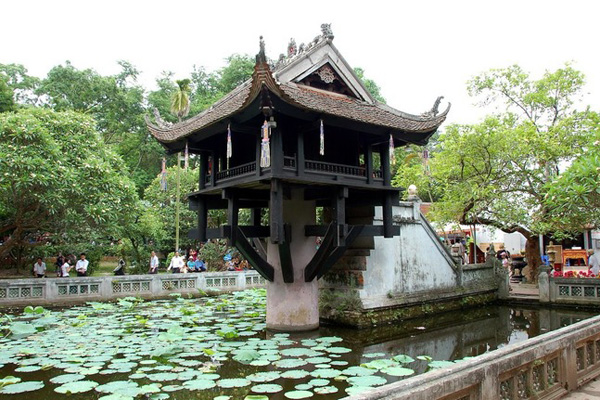
Ch'an Master Hue Sinh (7-1063), whose real name was Lam Khu from An Vu Village (in present-day Thanh Tri District, Hanoi), was handsome and a skilled orator. He is famous for his excellent literary compositions and handwriting. He left home at the age of nineteen and joined the Vinitaruci Ch'an school. He was highly regarded for his knowledge of Buddhism. Hearing of his fame, King Ly Thanh Tong invited him to the Palace to teach. After refusing several times, Hue Sinh agreed to pay honor to the King. He received the King's compliments as well as a big reward and the title Tang thong. Hue Sinh complied with the King's order to compose epitaphs for many pagodas like Thien Phuc, Thien Khanh, Khai Quoc, Dieu Nghiem, and Bao Duc. He also wrote many books on how to practice Zen and worship. Hue Sinh once famously answered a question of King Ly Thai Tong about Buddhist philosophy by stating:
"Dharma" is not different from "non-dharma"
No existence; no non-existence If you grasp this truth,
You can see the Buddha and sentient beings have no difference.
The Lanka moon is serene
The Prajna (sea-crossing) boat is empty
Knowing that "absence of nothingness" is "existence"
You will understand Samadhi.
Ch'an Master Vien Chieu (999-1090), whose real name was Mai Truc, was the son of Queen Mother Linh Cam's brother. Linh Cam was King Ly Thai Tong's wife. Vien Chieu was intelligent, studied hard, and became a monk at a very young age due to the opinion of a senior monk at the Mat Nghiem Pagoda that he would be a Bodhisattva if he became a monk. Following the Vo Ngon Thong Ch'an school, Vien Chieu wrote many books interpreting Buddhism: Duc su thap nhi nguyen van, Tan Vien giac kinh, Thap nhi Bo Tat hanh tu chung dao trang, and Tham do hien quyet. King Ly Nhan Tong sent Van Chieu's book, Duoc su thap nhi nguyen van (Twelve Wishes of Bhaisajyaguru-vaidurya-prabhasa), to China for revision by eminent monks. After reading it, the eminent Chinese monks reported to King Tong Tiet Ton that, "these comments on the Buddhist sutras compiled by the
Mahasattvas incarnate in the Southern country are very profound. We, ordinary monks, dare not make any corrections."
Ch'an Master Thong Bien (?-1134), whose family name was Ngo, came from Dan Phuong (in present-day Ha Dong). From his childhood, he studied very hard and understood well the Three Doctrines (Confucianism, Buddhism, and Taoism). He became a disciple of Vien Chieu and spent his religious life in the Quoc Tu Pagoda under the official name of Tri Khong. Thong Bien was often invited to the Palace to give lectures on Buddhism and Buddhist history. Paying respect to his talent, the Royal Court bestowed on him the title Tang luc and promoted him to the position of Imperial Buddhist Preceptor.
C'h'an Master Vien Thong (1080-1151), whose real name was Nguyen Nguyen Uc, came from Co Phap Village, Thang Long. He was very intelligent. He became a monk at a very early age, adopting the Vinitaruci Ch'an school. He became the first laureate of the exam on Three Doctrines in 1097 and the Hoang Tai exam in 1098, but he refused to accept any title conferred by the King. He focused on teaching Buddhism in the Palace and attained the rank of Imperial Buddhist Preceptor. In 1130, asked by King Ly Than Tong about the philosophy of governance, he answered: "Commoners are like things that may be kept either untroubled or turbulent, depending on where they are installed. If the king's actions and virtues show compassion for the people, the latter will venerate him as their parent, the sun or the moon. And this means that society is kept in peace."
Under Ly Thai Tong's reign, there were many famous Ch'an masters from the Vinitaruci Ch'an school, the Wu Yan Tong school, and the Cao Tang school, who was very highly respected by the King and often took part in court affairs. Among them were Cuu Chi, Da Bao, Bao Tinh, Minh Tam, Dinh Huong (?-1051), Thien Lao (?-?), Sung Pham (1004-1087), Man Giac (1052-1096), Ngo An (1019-1088), Khong Lo (7-1119), Quan Nghiem (1121-1190) and Dinh Giac.
According to some researchers, Tantrism appeared in Vietnam at the same time as Ch'an ideologies of Indian monks like Mahajivaka, K'ang Seng Houei, and K'sudara. Although it was not considered an official religion, Tantrism had a great influence on Buddhism in Vietnam, Ch'an sect and Pure Land sect. In the tenth and eleventh centuries, Buddhism in Vietnam tended to center around Tantrism, especially in terms of leading a religious life and practicing Tong try Tam muoi (Dharanisamadhi), which focused on keeping the body mystic and reading incantations. Famous Ch'an masters like Ma Ha, Khong Lo, Nguyen Hoc, Giac Hai, Van Hanh, and Khuong Viet were deeply influenced by Tantrism. Buddhist scripture pillars built by the Dinh Kings in Hoa Lu also had incantations in the style of Tantrism. During this period, Buddhism was influenced by both Tantrism and Daoism. The friendship between Giac Hai and Daoist Thong Huyen is one example of this. King Ly Nhan Tong composed verses in praise of this relationship as follows:
Giac Hai's heart is as immense as the sea Thong Huyen's way is so miraculous Performing miracles and magic One is a Buddhist and the other — an immortal.
Under the Tran Dynasty, Buddhism in Vietnam became the national religion. The Tran Kings, together with the nobility, whole-heartedly supported Buddhism. The first king of the Tran Dynasty was Tran Thai Tong. With the interests of the Tran Dynasty in mind, Prime Minister Tran Thu Do, who was the mainstay of the Dynasty, advised him to divorce his wife, Chieu Thanh, and marry his sister-in-law, Thuan Thien. Unable to follow the advice, he went to Yen Tu to become a monk. There, he was encouraged by the Hoa Yen monks to go back to the Royal Court: "The mountain itself does not have Buddha. The Buddha is in our minds. If our mind is serene, wisdom will come to it-that is Buddha. If Your Majesty can be enlightened, you can become Buddha at once. There's no need to look somewhere else. Buddha is the mind, the mind is Buddha." During his 33- year reign, from 1225 to 1258, Tran Thai Tong governed the country while studying Buddhism, becoming well-versed in it. The King often discussed Buddhism with famous Vietnamese and Chinese monks such as Ung Thuan, Tuc Luc, Dai Dang, and Thien Phong. Tran Thai Tong himself composed six works including essays on Buddhism and literary books imbued with Buddhist thought, such as Thien Tong chi nam, Luc thoi sam hoi khoa nghi, Kim cuong tam muoi chu giai, Binh dang le sam van, Thai Tong thi tap, and Khoa hu luc. Tran Thai Tong's books on Buddhism were influenced by the Ch'an sect, the Pure Land sect, (Confucianism, and Taoism, especially the Wu Yan Tong Ch'an sect through the Imperial Buddhist Preceptor Truc Lam, and the Lin Ji sect through the layman Thanh Phong from China.
The Buddhist thoughts of Tran Thai Tong focused on human suffering, birth, aging, disease, and death, and on anatman and impermanence. He wrote that humans should be enlightened, do charitable deeds, avoid wicked behavior, cultivate virtue and morality, sit in meditation, and practice Ch'an. He wrote about rupakaya and the enlightenment, saying:
Under the Tran Dynasty, many other kings made very important contributions to the development of Buddhism at that time. Tue Trung, whose real name was Tran Tung (1230-1291), was a son of Tran Lieu and a brother of Tran Quoc Tuan. He was a student of layman Ung Thuan, who proved his great merit in the resistance war against the Yuan invaders. He was promoted to Governor of Thai Binh. He later resigned and practiced Ch'an at home. Tue Trung was a great Ch'an scholar of the Tran Dynasty. He studied Buddhism from Ch'an Master Tieu Dieu, who himself had been a student of Ch'an Master Dai Dang and layman Ung Thuan. Because of his prestige and knowledge of Ch'an, King Tran Thanh Tong gave him the title Thuong sy (Superior Disciple of Ch'an). Tue Trung wrote the work Tue Trung Thuong sy Ngu luc which was full of his profound Ch'an thoughts, which focused on emptiness, impermanence, and enlightenment:
From "non-existence" emerges "existence"
"Existence" and "non-existence" are no different The same are "affliction" and “Bodhi" (perfect wisdom)
And no "suchness of existence" and no "misleading thoughts." Or In the illusion, one distinguishes "emptiness" and "outward appearance"
When enlightened, one stops such distinction "Emptiness" and "outward appearance" are no different Such are "illusion'' and "enlightenment."
Although he was a famous Ch'an scholar, Tue Trung maintained a close link to reality and understood the lives of ordinary people. He was not conservative or intolerant but was light-hearted and attached to nature.
How spacious is Phuc Duong (name of his hermitage)
And well-ventilated with Ch'an winds
The thin fence is adorned with slim bamboo sprouts
The courtyard shrouded in wild pine trees
The time is not ripe for talents to emerge
Yet deep forests are a good shelter for valuable animals
Sooner or later, old Heaven will expose Buddha's sun
And then peaches and apricots at the gate will enjoy spring sunlight.
Tran Nhan Tong (1258-1308), whose real name was Tran Kham, was the first son born to King Tran Thanh Tong and Queen Mother Nguyen Thanh Thien Cam. Tran Nhan Tong was the fourth king of the Tran Dynasty. He took the throne at the age of twenty. Fostering great unity among the people, KingTran Nhan Tong won two glorious resistance wars against the Yuan invaders in 1258 and 1285. After holding power for fifteen years, Tran Nhan Tong handed down the throne to his son Anh Tong in 1293 and became the King Father. In 1299, he went to Yen Tu Mountain to become a monk and took the name Huong Van Dai Dau Da, or Truc Lam Dau Da (patriarch of Bamboo Forest Buddhist sect). Tran Nhan Tong traveled far and wide to teach Buddhism and practice Ch'an, to such places as the Pho Minh Pagoda in Thien Truong, the Sung Nghiem Pagoda in Chi Linh, the Bao An Pagoda in Sieu Loai, and the Vinh Nghiem Pagoda in Lang Giang. In 1301, Tran Nhan Tong went to Chiem Thanh to learn more about Buddhism and build a peaceful relationship with the people there. While there he promised to give Princess Huyen Tran in marriage to the King of Chiem Thanh, Che Man. In his life, Tran Nhan Tong was a king, a Ch'an scholar, and a great poet. He wrote many works. Tran Nhan Tong's prose was deeply influenced by Buddhist philosophies which upheld consistency between religion and everyday life, between monkhood and normal human life. He wrote the following gatha:
Nothing is born
Nothing dies
If you understand this
The Buddha will show up to your eyes
"Appearance" and "disappearance" are no more a question.
Tran Nhan Tong felt light-hearted about human life:
Life is as short as a breath
Human sentiments are like the moon and the sea
The royal palace is worthless.
Nobless is greater than in the Buddha's land.
Tran Nhan Tong was a Ch'an scholar, but he did not seek to escape from worldly life with worldly affairs. He described one peaceful afternoon in Thien Truong Prefecture (present-day Nam Dinh) as follows:
At sunset, hamlets are shrouded in a pink mist
And in the twilit gloom
Buffaloes walk home leisurely to the buffalo boy's horn White storks, in flocks, swoop down on the rice field.
Tran Nhan Tong was a great Buddhist scholar who contributed much to make Buddhism in Vietnam prosper. Tran Nhan Tong's writings also contributed to the body of original Buddhist literature created under the Ly and Tran Dynasties.
Under the Tran Dynasty, the Truc Lam Yen Tu Ch'an sect emerged. It was in reality the fourth success of the Yen Tu tradition belonging to the Wu Yan Tong Ch'an sect. However, in the time of King Tran Nhan Tong, it became an independent sect with three main patriarchs: Tran Nhan Tong, Phap Loa (1284 - 1330), and Huyen Quang (1254-1334). The Truc Lam Yen Tu Ch'an sect brought together all of the Ch'an sects in Vietnam, including Vinitaruci, Wu Yan Tong, and Cao Tang. With such a prominent role, the Truc Lam Yen Tu Ch'an sect was considered the first foundation for unifying Buddhist sects in Vietnam. So It was also called the United Buddhism (Phat giao Nhat tong) or Vietnam Buddhist Congregation (Giao hoi Phat giao Vietnam). However, the Truc Lam Yen Tu Ch'an sect was short-lived. When the Tran Dynasty collapsed, it was no longer considered a sect.
Under the Tran Dynasty, there were many renowned monks. Huyen Quang and Phap Loa should be mentioned. Phap Loa's real name was Dong Kien Cuong. He was born in 1284 in Dong Hoa Village (Nam Sach, Hai Duong). From an early age, Phap Loa showed intelligence and admiration for Buddhism. He became a monk in 1304 when Tran Nhan Tong traveled to the Nam Sach legion to teach Buddhism. In 1308, Phap Loa underwent the "mind-to-mind transmission" of Buddhist truth and became the second succession of the Truc Lam Ch'an sect. Under the leadership of Phap Loa and others; the Truc Lam sect - Vietnam Buddhist Congregation - became stronger and stronger. It printed copies of Tripitaka, convened Buddhist assemblies for sermons and ordaining monks, built pagodas and cast statues, and carried out social welfare projects. Phap Loa also composed many works; yet unfortunately, most of them have not survived, except for fragments of his work titled Tham thien yeu chi. Phap Loa's works not only concern the study and practice of Ch'an but also bear literary value. He wrote:
The autumn river floats in solitude
High mountains mirror themselves in serene water
In front of me, the way thousands of miles far away
It leads my look to eternity
(Nostalgia for the Thanh Son landscape)
Huyen Quang, whose real name was Ly Dao Tai, was born in 1254 in Van Ta Village, Lang Giang. Huyen Quang's appearance was unusual, but he was very intelligent and knowledgeable. At the age of twenty, Huyen Quang scored the highest mark on a court examination and was recruited as a mandarin. Because of his talent and broad knowledge, he was often assigned by the king to receive envoys from China. In 1305 when he was fifty- one year old, after twenty years serving as a mandarin, Huyen Quang resigned and adopted a monastic life. This happened after he had joined Tran Anh Tong at the Vinh Nghiem Pagoda to hear Phap Loa's sermon. In 1306, he was initiated into monkhood by Bao Phac at the Vu Ninh Pagoda. Although he adopted monkhood when he was quite old, Ch'an Master Huyen Quang became the third succession of the Truc Lam Ch'an sect. After the deaths of Phap Loa and Tran Nhan Tong, Huyen Quang led the Truc Lam sect. Huyen Quang wrote many books about Buddhism. Unfortunately, only twenty poems have survived, including one in praise of the Van Yen Pagoda. The writings are very simple but philosophical. For instance, he wrote about Dien Huu Pagoda:
The wall prevents worldly dust and troubles
The windows open for carefree eyes to broaden their vision
To see ‘the right" and "the wrong" as two sides of the same coin
And the Maras' realm and the Buddha's realm are no different.
Under the Tran Dynasty, with the support and encouragement of powerful kings and mandarins and the emergence of the Truc Lam Ch'an sect, Buddhism developed strongly in the capital and rural areas. The kings had pagodas constructed in the royal citadel, others renovated and repaired, and new pagodas built in many places. Almost every village had a pagoda, which together with a communal house came to typify the Vietnamese village.
Dien Huu Pagoda
In his time, Phap Loa had five stupas and two large Buddhist centers built at Quynh Lam and Bao An, more than 200 cloisters, and 1,300 Buddhist statues cast. In 1322, after hearing Phap Loa's sermon, court mandarins donated thousands of Buddhist statues. In 1324, Prime Minister Van Hue Vuong and Princess Thuong Tran donated 900 kilograms of gold to cast a statue of Matreya. Truc Lam patriarchs put much effort into the printing of Buddhist sutras, and in 1331 Phap Loa assigned Bao Sat to organize the printing of Tripitaka, which was brought from China under the Ly Dynasty and preserved in Thien Truong Prefecture. In 1319, the clergy and laypeople donated blood to printing 5,000 copies of Tripitaka to be stored at the Quynh Lam Pagoda. Ten years later, in 1329, Phap Loa ordered 5,000 books printed, including the works of Tran Thai Tong, Tue Trung, and his own. Importance was attached to the training of the clergy and ordination. As the leader of the Shangha, Phap Loa organized many Buddhist assemblies to initiate kings, royal members, and people into Bodhisattvasila. Thanks to his leadership, over a period of twenty years, the number of monks and nuns in the country grew to 15,000. Buddhism in Vietnam also benefited from the wide support of the court at this time. In 1308, King Tran Anh Tong donated 100 mau of rice fields owned by the Tran family to Bao An pagoda. In addition, he gave Phap Loa 500 mau of rice fields and 50,000 piastres in support of Triratna and as alms to the poor. Queen Mother Bao Tu donated 300 mau of rice fields to the Sieu Loai Pagoda. Prime Minister Hue Vuong donated 7,000 piastres and 75 mau of rice fields to the Quynh Lam Pagoda.
The Ly and Tran were the two strongest and most stable dynasties in Vietnamese history. They both made brilliant achievements in civil administration and military affairs. Under the Ly and Tran Dynasties, Buddhism prospered, making positive and active contributions to the country. However, at the end of the Tran Dynasty, especially from the time of King Tran Hien Tong onwards, the Dynasty began to decline and Buddhism was no longer as influential as it once was.

